Chefs' Warehouse Bundle
How Did Chefs' Warehouse Rise to Culinary Prominence?
Journey back in time to uncover the fascinating Chefs' Warehouse SWOT Analysis and the remarkable transformation of a family business. From its humble beginnings as The Veterans Butter & Egg Company in 1956, this food distributor has become a powerhouse in the culinary industry. Discover how a vision to supply high-quality ingredients to chefs propelled this company to the forefront of the restaurant suppliers market.
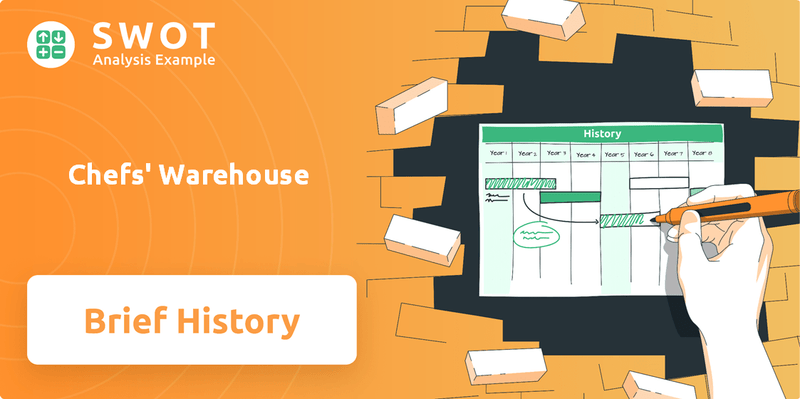
The Chefs' Warehouse history is a compelling narrative of strategic adaptation and expansion. Initially focused on specialty food products, the company's evolution mirrors the changing demands of the culinary world. Today, with a vast product catalog and a global presence, the company's financial success and market position reflect its commitment to quality and innovation. This brief history of Chefs' Warehouse demonstrates how a keen understanding of the food industry can lead to significant growth.
What is the Chefs' Warehouse Founding Story?
The story of Chefs' Warehouse, a prominent name in the culinary industry, began in 1956. It started as The Veterans Butter & Egg Company in New York City, founded by two cousins, including Peter Pappas. This marked the early days of what would become a significant food distributor.
The transformation to the Chefs' Warehouse we know today was driven by Peter's sons, Christopher and John Pappas. Their vision was to bring high-quality, specialized ingredients to American chefs, a need they identified through Christopher's experiences abroad. This shift from a basic butter and egg supplier to a purveyor of premium products was a pivotal moment.
The company's evolution reflects a keen understanding of the culinary world's needs. Their initial focus was on sourcing and distributing specialty foods, pastry and bakery items, and center-of-the-plate proteins directly to chefs. The transition from The Veterans Butter & Egg Company to Dairyland USA and eventually to The Chefs' Warehouse highlights their commitment to serving the culinary industry.
The Chefs' Warehouse, a leading food distributor, traces its roots back to 1956 with The Veterans Butter & Egg Company.
- Founded by Cypriot immigrant cousins, including Peter Pappas, in New York City.
- Christopher and John Pappas transformed the business, inspired by European culinary traditions.
- Focused on providing high-quality, specialized ingredients to fine-dining establishments.
- Evolved from The Veterans Butter & Egg Company to Dairyland USA, and finally, The Chefs' Warehouse.
Chefs' Warehouse SWOT Analysis
- Complete SWOT Breakdown
- Fully Customizable
- Editable in Excel & Word
- Professional Formatting
- Investor-Ready Format
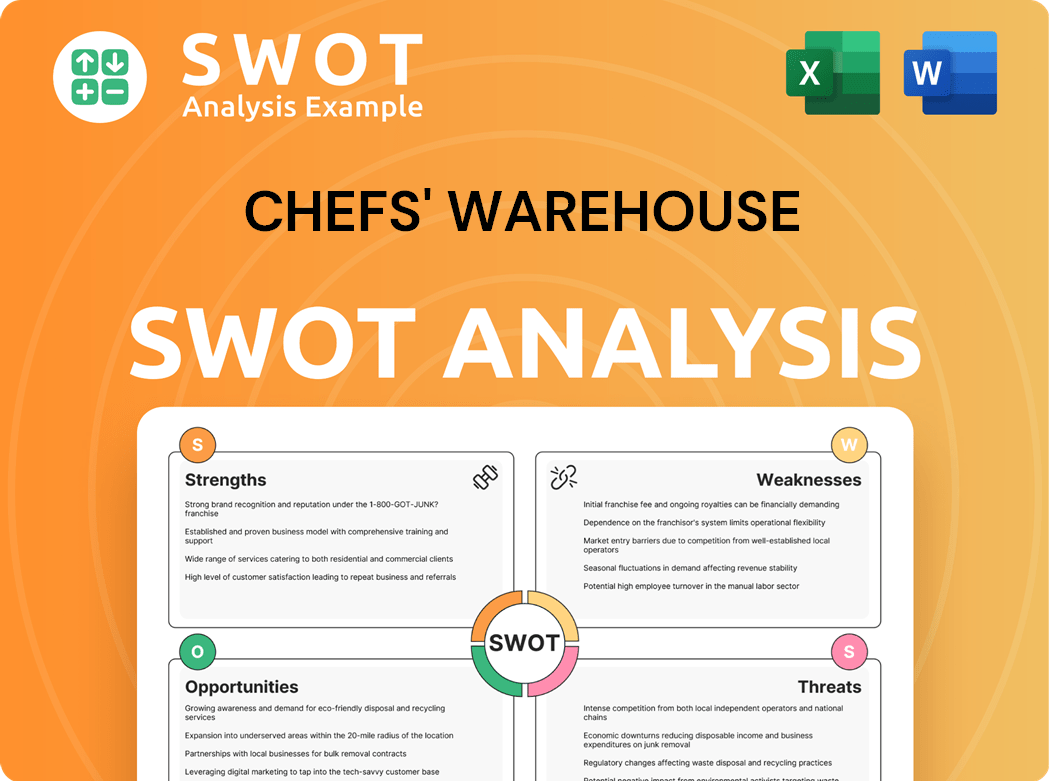
What Drove the Early Growth of Chefs' Warehouse?
The early growth and expansion of The Chefs' Warehouse, building on its origins, centered on strategic moves to become a leading food distributor. This involved expanding its distribution network, increasing its product offerings, and broadening its customer base within the culinary industry. The company achieved this through a combination of organic growth and strategic acquisitions, solidifying its position as a key player in the market.
Initially, The Chefs' Warehouse focused on establishing itself as a premier food distributor, primarily targeting high-end culinary establishments. This strategy involved cultivating relationships with chefs at independent restaurants, country clubs, hotels, and catering companies. This focus allowed the company to build a strong reputation within the culinary world.
A key part of The Chefs' Warehouse's growth strategy has been strategic acquisitions to expand its geographic reach and product offerings. For instance, the acquisition of American Gourmet in 2008 boosted its presence in the Mid-Atlantic market. Further acquisitions, such as Provvista Specialty Foods in 2012, expanded its reach. The company has completed 11 acquisitions by April 2025.
Significant acquisitions allowed The Chefs' Warehouse to enter new markets. The acquisition of Qzina Specialty Foods in 2013 marked its entry into Canada. The company entered the Chicago market through the acquisition of Allen Brothers. These moves have helped the company broaden its international footprint, including the United Arab Emirates.
The Chefs' Warehouse has demonstrated robust financial growth. Net revenues reached $1.6 billion by the end of 2019, up from approximately $1.2 billion in 2016. The company achieved a record $1 billion in revenue in a single quarter for the first time in Q4 2024. They have invested in distribution and warehouse management systems. As of Q1 2025, 58% of domestic specialty customers order online, up from 48% in 2023.
Chefs' Warehouse PESTLE Analysis
- Covers All 6 PESTLE Categories
- No Research Needed – Save Hours of Work
- Built by Experts, Trusted by Consultants
- Instant Download, Ready to Use
- 100% Editable, Fully Customizable
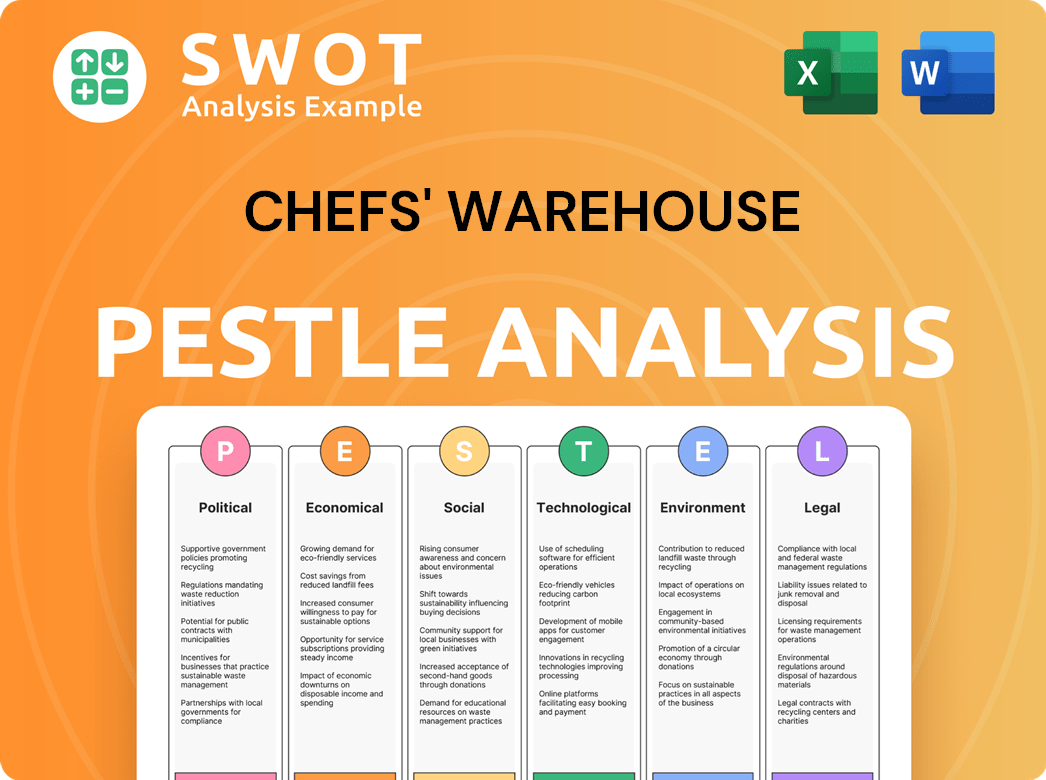
What are the key Milestones in Chefs' Warehouse history?
The Chefs' Warehouse company has a rich history marked by strategic growth and adaptation within the culinary industry. The company's journey includes significant acquisitions, technological advancements, and responses to market challenges, shaping its position as a leading food distributor.
| Year | Milestone |
|---|---|
| 2020 | Completed acquisitions of Sid Wainer & Son and Cambridge Packing Company Inc., expanding product offerings and market reach. |
| 2021 | Acquired Foley Fish, further diversifying its seafood offerings and strengthening its presence in the restaurant suppliers market. |
| 2022 | Acquired Chef Middle East, extending its geographic footprint and enhancing its international presence. |
| 2023 | Held 12 registered trademarks and 7 proprietary distribution method patents, showcasing commitment to intellectual property. |
| 2024 | Expanded distribution capacity to approximately 3.0 million square feet across 49 facilities as of December 27, 2024. |
| 2025 | Completed 11 acquisitions by April 2025, continuing its growth through strategic partnerships. |
The Chefs' Warehouse has consistently invested in advanced warehousing, inventory control, and distribution systems. This has allowed the company to maintain high service levels, with an average distribution service level exceeding 97% as of fiscal year ended December 27, 2013.
The company has significantly invested in its digital platform to enhance customer engagement. As of Q1 2025, 58% of domestic specialty customers ordered online, a notable increase from 48% in 2023.
The company holds 7 proprietary distribution method patents, reflecting its commitment to unique operational approaches. These innovations improve efficiency and customer service within the food distributor sector.
Acquisitions like Sid Wainer & Son and Chef Middle East have been key to expanding product categories and geographic reach. These moves have helped the company to better serve the culinary industry.
Investments in new facilities, including locations in Florida, Los Angeles, and Northern California, support growth. This expansion increases distribution capacity and enhances service capabilities.
The foodservice distribution industry presents several challenges for the Chefs' Warehouse. These include intense competition from smaller distributors and the impact of economic factors on profitability.
The industry is highly competitive, featuring numerous smaller distributors and a limited number of national broadline distributors. This competition impacts pricing and market share within the restaurant suppliers sector.
Rising distribution costs and competition for salespeople can affect profitability. In Q1 2025, gross profit margins decreased by approximately 18 basis points to 23.8%, indicating cost pressures.
Economic conditions, inflation, and changes in consumer spending significantly influence profitability. Organic pounds sold in the center-of-the-plate category decreased by 1.3% in Q1 2025, reflecting these impacts.
Complex trade policies and import tariffs, ranging from 5.5% to 37.5% depending on the product category, pose potential challenges. These tariffs can affect the cost of goods and overall profitability.
Chefs' Warehouse Business Model Canvas
- Complete 9-Block Business Model Canvas
- Effortlessly Communicate Your Business Strategy
- Investor-Ready BMC Format
- 100% Editable and Customizable
- Clear and Structured Layout
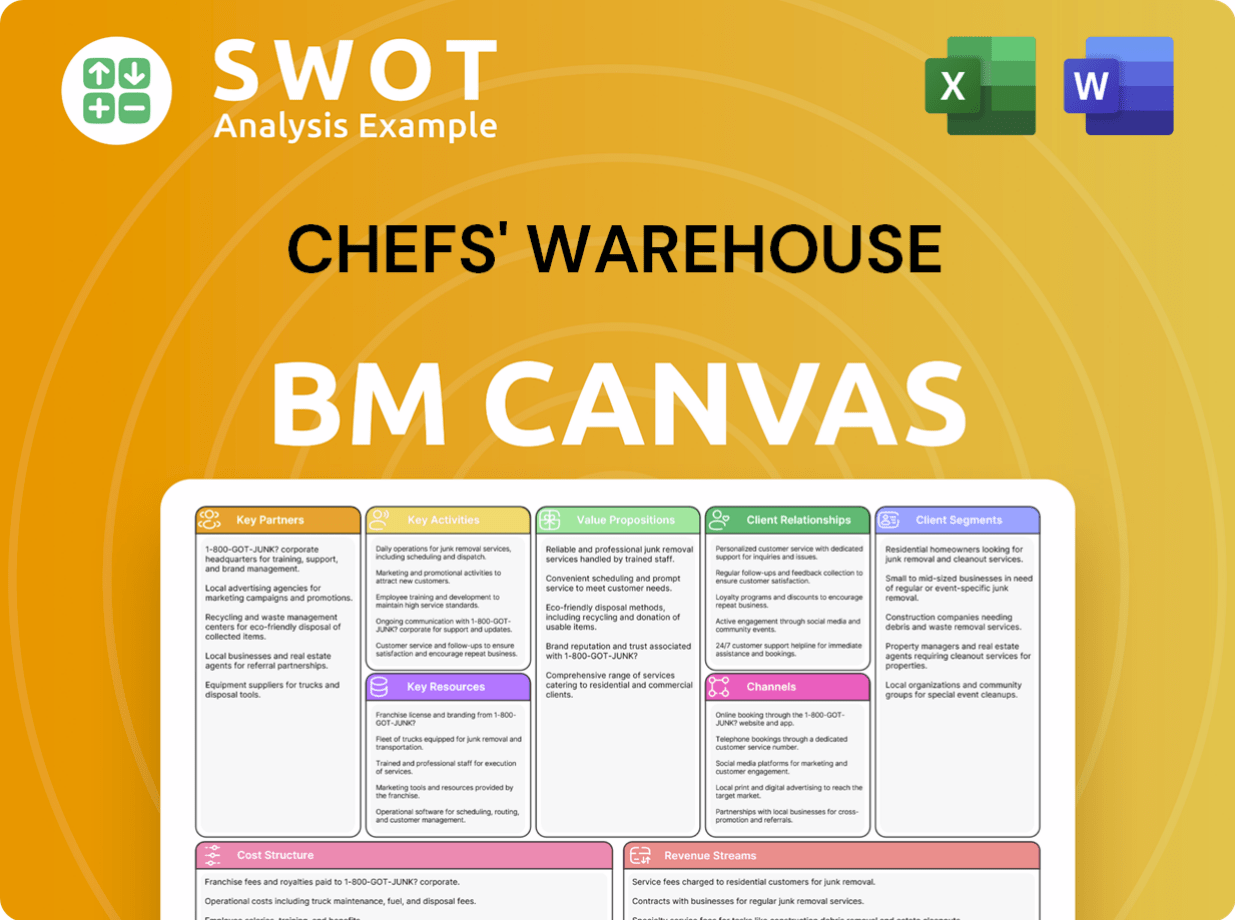
What is the Timeline of Key Events for Chefs' Warehouse?
The Chefs' Warehouse company has a rich history, beginning in 1956 with the founding of Veterans Butter & Egg Company. Over the years, it has evolved through strategic acquisitions and expansions, from its transformation into Dairyland USA in 1985 to its significant growth in the 21st century. Key milestones include entering the Midwest and Canadian markets in 2012 and 2013, respectively, and expanding internationally in 2022 with the acquisition of Chef Middle East. The company's focus on growth and operational efficiency continues to shape its trajectory in the culinary industry.
| Year | Key Event |
|---|---|
| 1956 | Peter Pappas and his cousin founded Veterans Butter & Egg Company in New York City, the precursor to Chefs' Warehouse. |
| 1985 | Christopher and John Pappas transformed the family business into Dairyland USA, aiming to become a major food distributor. |
| 2008 | The company expanded its Mid-Atlantic market presence through the acquisition of American Gourmet. |
| 2012 | Chefs' Warehouse acquired Provvista Specialty Foods, Inc., Praml International, LTD, and entered the Midwest market via Michael's Finer Meats, LLC. |
| 2013 | The company acquired Queensgate Foodservice and Qzina Specialty Foods, entering Canada, and also entered the Chicago market via Allen Brothers. |
| 2014 | Distribution centers were established in Seattle, WA, and Tempe, AZ. |
| 2016 | M.T. Food Service Inc. was acquired in Chicago, accelerating regional growth. |
| 2020 | Sid Wainer & Son and Cambridge Packing Company Inc. were acquired. |
| 2021 | Foley Fish was acquired, enhancing seafood distribution capabilities. |
| 2022 | University Foods in Los Angeles, CA, and Alexis Foods in Portland, OR, were acquired, and Chef Middle East expanded the company internationally. |
| May 1, 2023 | GreenLeaf was acquired. |
| Fiscal Year 2024 | Achieved a record $1 billion in quarterly revenue for the first time, and acquired GreenLeaf and Hardie's Fresh Foods. |
| January 28, 2025 | GreenLeaf expanded produce distribution to Southern California. |
| February 12, 2025 | Reported strong fourth quarter 2024 financial results. |
| March 13, 2025 | Hosted an Investor Day in New York City. |
| April 30, 2025 | Reported strong first quarter 2025 financial results. |
For fiscal year 2025, Chefs' Warehouse anticipates net sales between $3.96 billion and $4.04 billion. Gross profit is projected to be between $954 million and $976 million. Adjusted EBITDA is expected to range from $234 million to $246 million.
The company plans to continue investing in technology to boost efficiency and customer service. They also intend to focus on organic growth through hiring and new category development, along with strategic acquisitions to broaden product offerings.
Chefs' Warehouse is committed to maintaining S&P Global Ratings-adjusted leverage in the mid-3x area, with a forecast of approximately 3.4x by the end of 2025. They aim to generate free operating cash flow of around $90 million in 2025 and anticipate capital expenditures of about $50 million.
Digital adoption is a key focus, with 58% of domestic specialty customers now ordering online. This shift towards digital platforms positions Chefs' Warehouse for sustained growth and improved customer engagement in the culinary industry.
Chefs' Warehouse Porter's Five Forces Analysis
- Covers All 5 Competitive Forces in Detail
- Structured for Consultants, Students, and Founders
- 100% Editable in Microsoft Word & Excel
- Instant Digital Download – Use Immediately
- Compatible with Mac & PC – Fully Unlocked
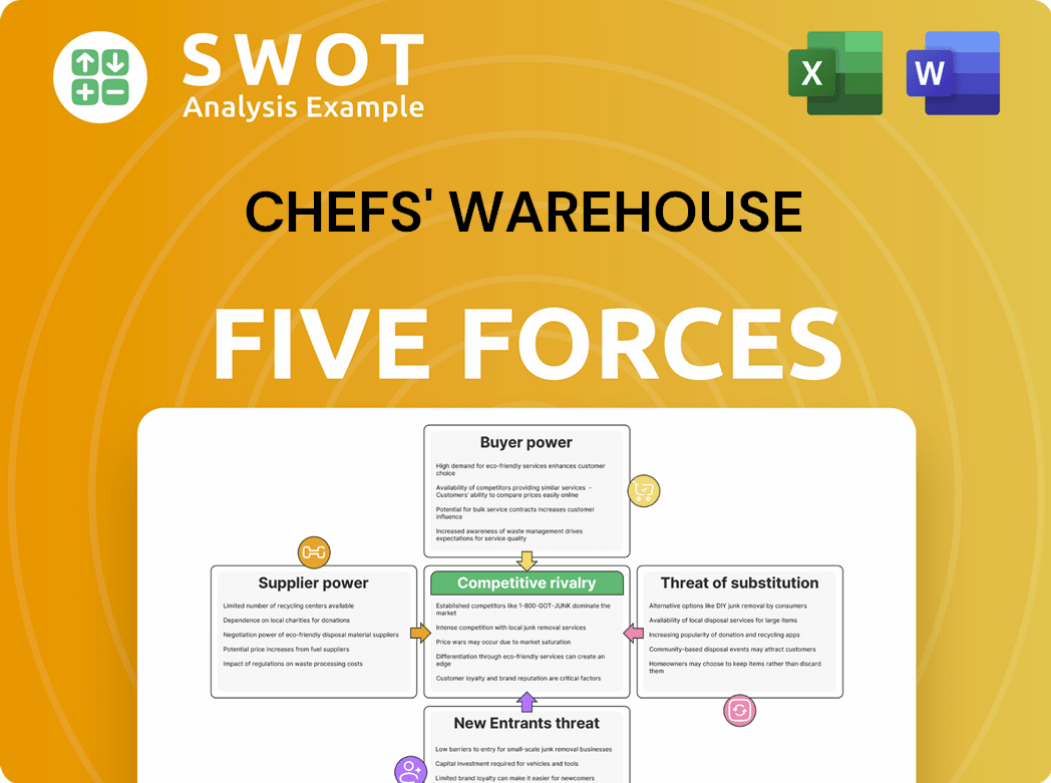
Related Blogs
- What is Competitive Landscape of Chefs' Warehouse Company?
- What is Growth Strategy and Future Prospects of Chefs' Warehouse Company?
- How Does Chefs' Warehouse Company Work?
- What is Sales and Marketing Strategy of Chefs' Warehouse Company?
- What is Brief History of Chefs' Warehouse Company?
- Who Owns Chefs' Warehouse Company?
- What is Customer Demographics and Target Market of Chefs' Warehouse Company?
Disclaimer
All information, articles, and product details provided on this website are for general informational and educational purposes only. We do not claim any ownership over, nor do we intend to infringe upon, any trademarks, copyrights, logos, brand names, or other intellectual property mentioned or depicted on this site. Such intellectual property remains the property of its respective owners, and any references here are made solely for identification or informational purposes, without implying any affiliation, endorsement, or partnership.
We make no representations or warranties, express or implied, regarding the accuracy, completeness, or suitability of any content or products presented. Nothing on this website should be construed as legal, tax, investment, financial, medical, or other professional advice. In addition, no part of this site—including articles or product references—constitutes a solicitation, recommendation, endorsement, advertisement, or offer to buy or sell any securities, franchises, or other financial instruments, particularly in jurisdictions where such activity would be unlawful.
All content is of a general nature and may not address the specific circumstances of any individual or entity. It is not a substitute for professional advice or services. Any actions you take based on the information provided here are strictly at your own risk. You accept full responsibility for any decisions or outcomes arising from your use of this website and agree to release us from any liability in connection with your use of, or reliance upon, the content or products found herein.